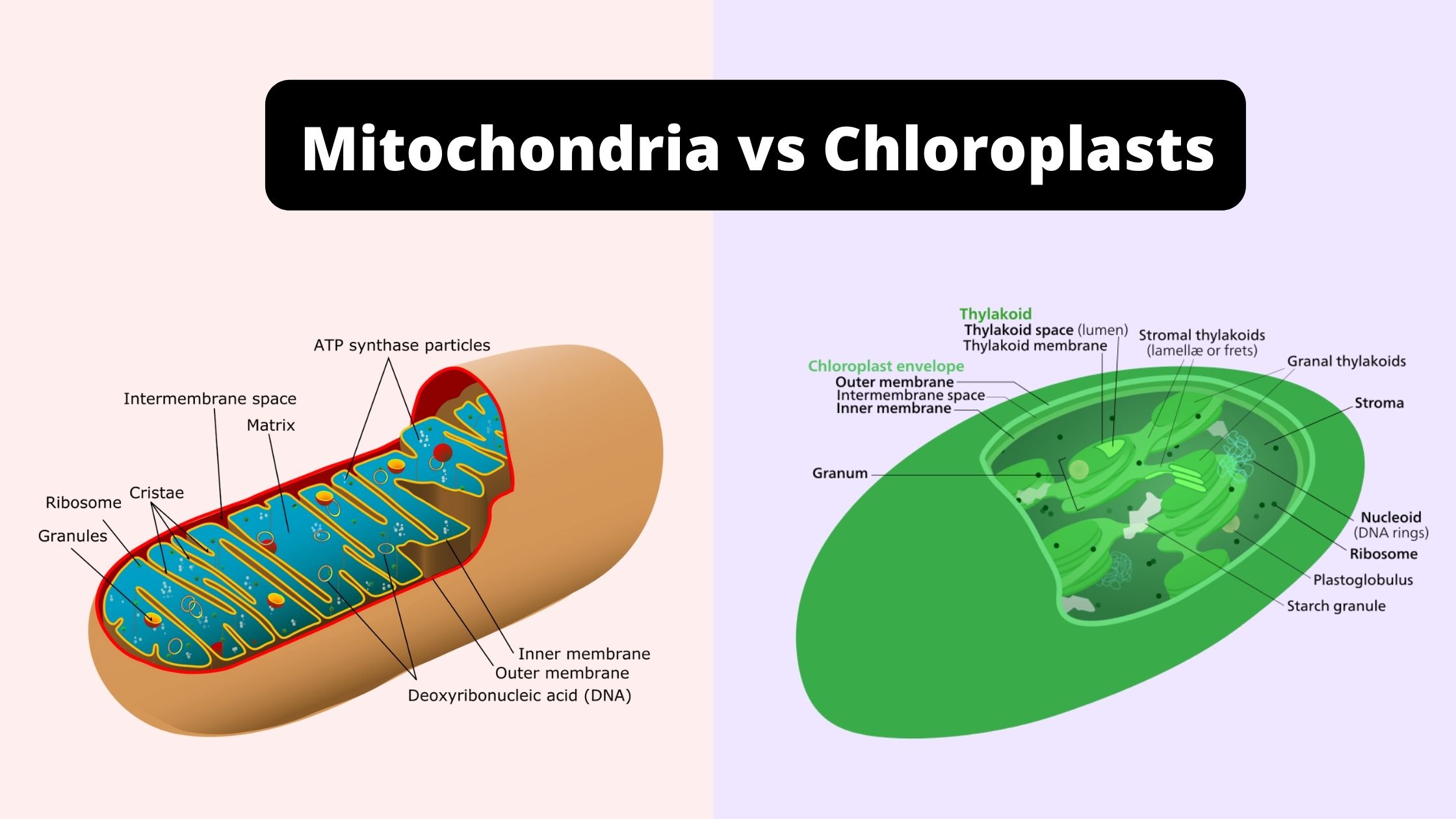Mitochondria and Chloroplast Are Two Types of
Illustrate the relationships among the membranes and compartments of a mitochondria and b chloroplasts by sketching simple concentric circles to represent the membranes. Plant cells contain two organelles originally derived from endosymbiotic bacteria.

Differences Between Mitochondria And Chloroplast Mitochondria Vs Chloroplasts
Their endosymbiotic origin explains why these organelles contain their own DNA nonetheless only a few dozens of genes are actually encoded by these genomes.

. Sequences from red algae other than cyanidiales and from other algae that possess red-lineage chloroplasts as a result of secondary endosymbiosis should give body and substance to the. Thus two cell organelles involved in energy transformation reactions. Name two other organelles besides the mitochondria that contain DNA and have a double membrane.
This captured energy into. Usually found in. The key difference between mitochondria and chloroplast is that mitochondria are the membrane-bound cell organelles that generate energy in the eukaryotic cells while chloroplast is a type of eukaryotic cell organelle that carries out photosynthesis in plants and algae.
One of the differences between mitochondria and chloroplasts is their presence. Mitochondria and chloroplast are semiautonomous organelles that share various structural similarities but the major difference is their occurrence. Scientists have long noticed that bacteria mitochondria and chloroplasts are similar in size.
Mitochondria can be found in the cells of all types of aerobic organisms such as plants and animals. Mitochondria are present in the cells of all types of aerobic organisms like plants and animals whereas Chloroplast is present in green plants and some algae protists like Euglena. We also know that mitochondria and chloroplasts have DNA and ribosomes just as bacteria do.
Chloroplast is where photosynthesis takes place. Mitochondria are the cells engine creating ATP during cellular respiration. When both chloroplasts and mitochondria are used plant cells take part in both photosynthesis and respiration.
In mitochondria the energy is captured and used to produce ATP by oxidative phosphorylation. Find step-by-step Biology solutions and your answer to the following textbook question. The inner membrane of mitochondria is folded into cristae while that of a chloroplast rises into flattened sacs called as thylakoids.
9 rows Mitochondria and chloroplast are organelles found in a plant cell. Mitochondria are membrane-bound organelles but theyre membrane-bound with two different membranes. Mitochondria are found in eukaryotic animal cells whereas chloroplasts are found in plant cells.
They have their own DNA which is separate from the DNA found in the nucleus of the cell. Scientists believe that host cells and bacteria formed a mutually beneficial endosymbiotic relationship when the host cells ingested aerobic bacteria and cyanobacteria but did not. Describe the functions of these two organelles and propose one structural evidence that strongly supports this endosymbiotic hypothesis.
Both mitochondria and chloroplast are two large organelles found in eukaryotic cells. In some ways mitochondria and chloroplasts are similar. As chloroplast converts sunlight into chemical energy photosynthesis and because mitochondria are the power powerhouse of each cell oxygen is kept flowing around the cell via a molecule known as glucose and oxygen is supplied.
In cytoplasm the energy is captured and used to produce ATP by substrate level phosphorylation during glycolysis. There are many similarities between mitochondria and chloroplasts but there are also some significant differences. Mitochondria and chloroplasts have striking similarities to bacteria cells.
Plant cells need both chloroplasts and mitochondria because they perform both photosynthesis and cell respiration. The two types of cellular power stations are organelles called chloroplasts mitochondria. Mitochondria and chloroplasts are two organelles that are found in cells.
Mitochondria and chloroplasts are two types of organelles in eukaryotic cells. Theyre responsible for capturing light energy to make sugars in photosynthesis. Mitochondria and chloroplasts are two types of _____.
Inner membrane outer membrane thylakoid membrane stroma thylakoid lumen matrix. Mitochondria Have DNA. However chloroplast is.
Chloroplasts and mitochondria have two membranes in order to control the chemicals that may. The Nucleus and the Chloroplast Why is the inner mitochondrial membrane folded. Up to 10 cash back This study showed that Cyanidioschyzon possesses two types of FtsZ for both mitochondria and plastids and provides additional evidence supporting our hypothesis.
Hope his helps if so please mark brainiest. Choose the appropriate labels for each sketchfrom the following list. 5 rows Chloroplast Mitochondria.
Mitochondria and chloroplasts likely began as bacteria that were engulfed by larger cells the endosymbiont theory. In chloroplasts the energy is captured and used to produce ATP by photophosphorylation. Mitochondria and chloroplast are considered to be semiautonomous because mitochondria contain DNA and can reproduce independently of the cell and cholorplasts have a built in feeding mechanism.
Current studies suggest that both organelles may have evolved by endosymbiosis of prokaryotes. Because both of them function to produce metabolic energy. In eukaryotic cells mitochondria and chloroplasts are both present.
One of the most significant differences is that mitochondria. So for example the muscle has a lot of mitochondria the liver does too the kidney as well and to a certain extent the brain which lives off of the energy those mitochondria produce. One harnesses light energy from the sun and the other unpacks.
Many of the other genes original. Mitochondria are responsible for energy production in cells while chloroplasts are responsible for photosynthesis. Chloroplasts are found in plants and algae.
And both organelles use their DNA to produce many proteins and enzymes required for their function. They share a double membrane and their own set of DNA. Chloroplast converts light solar energy into chemical energy during photosynthesis while mitochondria the powerhouse of the cell produces ATP- the energy currency of the cell during respiration.
Mitochondria are membrane-bound organelles found in almost all eukaryotic organisms.

Mitochondria Vs Chloroplast Diffzi
Difference Between Chloroplast And Mitochondria Structure Function Comparison

How Are Mitochondria And Chloroplasts Similar Mitochondria And Chloroplasts Similarities Lisbdnet Com
Comments
Post a Comment